Heat Transfer Modeling and Optimal Thermal Management of Electric Vehicle Battery Systems
Abstract
:1. Introduction
2. Numerical Simulation Methodology
2.1. Physical Problem
2.2. Numerical Analysis of the Electro-Chemical Model
2.2.1. Governing Equations in the Porous Electrodes (Anode and Cathode)
- Mass and charge conservation in the solid phase:
- Mass and charge conservation in the electrolyte (liquid phase):
- Electrochemical reactions at the solid–electrolyte interface:
2.2.2. Governing Equations in the Liquid Electrolyte (Separator)
2.3. Numerical Analysis of the Coupled Electrochemical-Thermal Battery Model
2.4. Conjugate Heat Transfer Modeling
3. Numerical Validation and Verification
3.1. Conjugate Heat Transfer Modeling
3.2. P2D-ECT Modeling
4. Multi-Objective Design Optimization of Cold Plate Minichannels
5. Results and Discussion
5.1. Hyperparameters Calibration
5.2. Single-Objective Optimization
5.3. Multi-Objective Optimization
6. Conclusions
Author Contributions
Funding
Data Availability Statement
Conflicts of Interest
References
- Malima, G.C.; Moyo, F. Are electric vehicles economically viable in sub-Saharan Africa? The total cost of ownership of internal combustion engine and electric vehicles in Tanzania. Transp. Policy 2023, 141, 14–26. [Google Scholar] [CrossRef]
- Mehlig, D.; Staffell, I.; Stettler, M.; ApSimon, H. Accelerating electric vehicle uptake favours greenhouse gas over air pollutant emissions. Transp. Res. Part D Transp. Environ. 2023, 124, 103954. [Google Scholar] [CrossRef]
- Sopha, B.M.; Purnamasari, D.M.; Ma’mun, S. Barriers and Enablers of Circular Economy Implementation for Electric-Vehicle Batteries: From Systematic Literature Review to Conceptual Framework. Sustainability 2022, 14, 6359. [Google Scholar] [CrossRef]
- Ben Lazreg, M.; Baccouche, I.; Jemmali, S.; Manai, B.; Hamouda, M. State of Charge Estimation of Lithium-ion Battery in Electric Vehicles Using the Smooth Variable Structure Filter: Robustness Evaluation against Noise and Parameters Uncertainties. Electr. Power Compon. Syst. 2023, 51, 1630–1647. [Google Scholar] [CrossRef]
- Zhan, J.; Deng, Y.; Ren, J.; Gao, Y.; Liu, Y.; Rao, S.; Li, W.; Gao, Z. Cell Design for Improving Low-Temperature Performance of Lithium-Ion Batteries for Electric Vehicles. Batteries 2023, 9, 373. [Google Scholar] [CrossRef]
- Lu, L.; Han, X.; Li, J.; Hua, J.; Ouyang, M. A review on the key issues for lithium-ion battery management in electric vehicles. J. Power Sources 2013, 226, 272–288. [Google Scholar] [CrossRef]
- Hussain, A.; Tso, C.Y.; Chao, C.Y.H. Experimental investigation of a passive thermal management system for high-powered lithium ion batteries using nickel foam-paraffin composite. Energy 2016, 115, 209–218. [Google Scholar] [CrossRef]
- Panahi, M.; Heydari, H.R.; Karimi, G. Effects of micro heat pipe arrays on thermal management performance enhancement of cylindrical lithium-ion battery cells. Int. J. Energy Res. 2021, 45, 11245–11257. [Google Scholar] [CrossRef]
- Faraji, H.; Teggar, M.; Arshad, A.; Arıcı, M.; Mehdi Berra, E.; Choukairy, K. Lattice Boltzmann simulation of natural convection heat transfer phenomenon for thermal management of multiple electronic components. Therm. Sci. Eng. Prog. 2023, 45, 102126. [Google Scholar] [CrossRef]
- Babaharra, O.; Choukairy, K.; Faraji, H.; Hamdaoui, S. Improved heating floor thermal performance by adding PCM microcapsules enhanced by single and hybrid nanoparticles. Heat Transf. 2023, 52, 3817–3838. [Google Scholar] [CrossRef]
- Hwang, F.S.; Confrey, T.; Reidy, C.; Picovici, D.; Callaghan, D.; Culliton, D.; Nolan, C. Review of battery thermal management systems in electric vehicles. Renew. Sustain. Energy Rev. 2024, 192, 114171. [Google Scholar] [CrossRef]
- Amorim, G.S.; Belman-Flores, J.M.; de Paoli Mendes, R.; Sandoval, O.R.; Khosravi, A.; Garcia-Pabon, J.J. Recent advancements in thermal management technologies for cooling of data centers. J. Braz. Soc. Mech. Sci. Eng. 2024, 46, 472. [Google Scholar] [CrossRef]
- Nobrega, G.; Cardoso, B.; Souza, R.; Pereira, J.; Pontes, P.; Catarino, S.O.; Pinho, D.; Lima, R.; Moita, A. A Review of Novel Heat Transfer Materials and Fluids for Aerospace Applications. Aerospace 2024, 11, 275. [Google Scholar] [CrossRef]
- Do, N.B.D.; Imenes, K.; Aasmundtveit, K.E.; Nguyen, H.V.; Andreassen, E. Thermally Conductive Polymer Composites with Hexagonal Boron Nitride for Medical Device Thermal Management. In Proceedings of the 2023 24th European Microelectronics and Packaging Conference & Exhibition (EMPC), Hinxton, UK, 11–14 September 2023; pp. 1–8. [Google Scholar]
- Li, M.; Wang, J.; Chen, Z.; Qian, X.; Sun, C.; Gan, D.; Xiong, K.; Rao, M.; Chen, C.; Li, X. A Comprehensive Review of Thermal Management in Solid Oxide Fuel Cells: Focus on Burners, Heat Exchangers, and Strategies. Energies 2024, 17, 1005. [Google Scholar] [CrossRef]
- Akinlabi, A.A.H.; Solyali, D. Configuration, design, and optimization of air-cooled battery thermal management system for electric vehicles: A review. Renew. Sustain. Energy Rev. 2020, 125, 109815. [Google Scholar] [CrossRef]
- Luo, J.; Zou, D.; Wang, Y.; Wang, S.; Huang, L. Battery thermal management systems (BTMs) based on phase change material (PCM): A comprehensive review. Chem. Eng. J. 2022, 430, 132741. [Google Scholar] [CrossRef]
- Zhao, G.; Wang, X.; Negnevitsky, M.; Li, C. An up-to-date review on the design improvement and optimization of the liquid-cooling battery thermal management system for electric vehicles. Appl. Therm. Eng. 2023, 219, 119626. [Google Scholar] [CrossRef]
- An, Z.; Jia, L.; Li, X.; Ding, Y. Experimental investigation on lithium-ion battery thermal management based on flow boiling in mini-channel. Appl. Therm. Eng. 2017, 117, 534–543. [Google Scholar] [CrossRef]
- Zhao, C.; Zhang, B.; Zheng, Y.; Huang, S.; Yan, T.; Liu, X. Hybrid Battery Thermal Management System in Electrical Vehicles: A Review. Energies 2020, 13, 6257. [Google Scholar] [CrossRef]
- Tete, P.R.; Gupta, M.M.; Joshi, S.S. Developments in battery thermal management systems for electric vehicles: A technical review. J. Energy Storage 2021, 35, 102255. [Google Scholar] [CrossRef]
- Arora, S. Selection of thermal management system for modular battery packs of electric vehicles: A review of existing and emerging technologies. J. Power Sources 2018, 400, 621–640. [Google Scholar] [CrossRef]
- Katoch, S.S.; Eswaramoorthy, M. A Detailed Review on Electric Vehicles Battery Thermal Management System. IOP Conf. Ser. Mater. Sci. Eng. 2020, 912, 042005. [Google Scholar] [CrossRef]
- Tuckerman, D.B.; Pease, R.F.W. High-performance heat sinking for VLSI. IEEE Electron Device Lett. 1981, 2, 126–129. [Google Scholar] [CrossRef]
- Mitra, I.; Ghosh, I. Mini-channel heat sink parameter sensitivity based on precise heat flux re-distribution. Therm. Sci. Eng. Prog. 2020, 20, 100717. [Google Scholar] [CrossRef]
- Kewalramani, G.V.; Agrawal, A.; Saha, S.K. Modeling of microchannel heat sinks for electronic cooling applications using volume averaging approach. Int. J. Heat Mass Transf. 2017, 115, 395–409. [Google Scholar] [CrossRef]
- Li, W.; Peng, X.; Xiao, M.; Garg, A.; Gao, L. Multi-objective design optimization for mini-channel cooling battery thermal management system in an electric vehicle. Int. J. Energy Res. 2019, 43, 3668–3680. [Google Scholar] [CrossRef]
- Wang, N.; Li, C.; Li, W.; Chen, X.; Li, Y.; Qi, D. Heat dissipation optimization for a serpentine liquid cooling battery thermal management system: An application of surrogate assisted approach. J. Energy Storage 2021, 40, 102771. [Google Scholar] [CrossRef]
- Zhang, F.; He, Y.; Wang, C.; Liang, B.; Zhu, Y.; Gou, H.; Xiao, K.; Lu, F. A new type of liquid-cooled channel thermal characteristics analysis and optimization based on the optimal characteristics of 24 types of channels. Int. J. Heat Mass Transf. 2023, 202, 123734. [Google Scholar] [CrossRef]
- Li, W.; Wang, Y.; Yang, W.; Zhang, K. Design and optimization of an integrated liquid cooling thermal management system with a diamond-type channel. Therm. Sci. Eng. Prog. 2024, 47, 102325. [Google Scholar] [CrossRef]
- Dong, H.; Chen, X.; Yan, S.; Wang, D.; Han, J.; Guan, Z.; Cheng, Z.; Yin, Y.; Yang, S. Multi-Objective Optimization of the Thermal Management System for a Lithium-Ion Battery Pack with a Novel Bionic Lotus Leaf Channel is Performed Using Nsga-Ii and Rsm. SSRN 2023. Available online: https://ssrn.com/abstract=4621052 (accessed on 8 September 2024).
- Liu, F.; Chen, Y.; Qin, W.; Li, J. Optimal design of liquid cooling structure with bionic leaf vein branch channel for power battery. Appl. Therm. Eng. 2023, 218, 119283. [Google Scholar] [CrossRef]
- Wu, C.; Ni, J.; Shi, X.; Huang, R. A new design of cooling plate for liquid-cooled battery thermal management system with variable heat transfer path. Appl. Therm. Eng. 2024, 239, 122107. [Google Scholar] [CrossRef]
- Feng, S.; Shan, S.; Lai, C.; Chen, J.; Li, X.; Mori, S. Multi-objective optimization on thermal performance and energy efficiency for battery module using gradient distributed Tesla cold plate. Energy Convers. Manag. 2024, 308, 118383. [Google Scholar] [CrossRef]
- Sui, Z.; Lin, H.; Sun, Q.; Dong, K.; Wu, W. Multi-objective optimization of efficient liquid cooling-based battery thermal management system using hybrid manifold channels. Appl. Energy 2024, 371, 123766. [Google Scholar] [CrossRef]
- Ren, H.; Jia, L.; Dang, C.; Qi, Z. An electrochemical-thermal coupling model for heat generation analysis of prismatic lithium battery. J. Energy Storage 2022, 50, 104277. [Google Scholar] [CrossRef]
- Kim, U.S.; Yi, J.; Shin, C.B.; Han, T.; Park, S. Modelling the thermal behaviour of a lithium-ion battery during charge. J. Power Sources 2011, 196, 5115–5121. [Google Scholar] [CrossRef]
- Gan, Y.; Wang, J.; Liang, J.; Huang, Z.; Hu, M. Development of thermal equivalent circuit model of heat pipe-based thermal management system for a battery module with cylindrical cells. Appl. Therm. Eng. 2020, 164, 114523. [Google Scholar] [CrossRef]
- Hou, G.; Liu, X.; He, W.; Wang, C.; Zhang, J.; Zeng, X.; Li, Z.; Shao, D. An equivalent circuit model for battery thermal management system using phase change material and liquid cooling coupling. J. Energy Storage 2022, 55, 105834. [Google Scholar] [CrossRef]
- Gao, Z.; Chin, C.S.; Woo, W.L.; Jia, J. Integrated Equivalent Circuit and Thermal Model for Simulation of Temperature-Dependent LiFePO4 Battery in Actual Embedded Application. Energies 2017, 10, 85. [Google Scholar] [CrossRef]
- Doyle, M.; Fuller, T.F.; Newman, J. Modeling of Galvanostatic Charge and Discharge of the Lithium/Polymer/Insertion Cell. J. Electrochem. Soc. 1993, 140, 1526. [Google Scholar] [CrossRef]
- Liu, J.; Yadav, S.; Salman, M.; Chavan, S.; Kim, S.C. Review of thermal coupled battery models and parameter identification for lithium-ion battery heat generation in EV battery thermal management system. Int. J. Heat Mass Transf. 2024, 218, 124748. [Google Scholar] [CrossRef]
- Mevawalla, A.; Panchal, S.; Tran, M.-K.; Fowler, M.; Fraser, R. Mathematical Heat Transfer Modeling and Experimental Validation of Lithium-Ion Battery Considering: Tab and Surface Temperature, Separator, Electrolyte Resistance, Anode-Cathode Irreversible and Reversible Heat. Batteries 2020, 6, 61. [Google Scholar] [CrossRef]
- Guo, S.; Li, J.; Wang, Y.; Wang, Z. Electrochemical-thermal coupling model of lithium-ion battery at ultra-low temperatures. Appl. Therm. Eng. 2024, 240, 122205. [Google Scholar] [CrossRef]
- An, F.; Zhou, W.; Li, P. A comparison of model prediction from P2D and particle packing with experiment. Electrochim. Acta 2021, 370, 137775. [Google Scholar] [CrossRef]
- Hariharan, K.S.; Tagade, P.; Ramachandran, S. Mathematical Modeling of Lithium Batteries from Electrochemical Models to State Estimator Algorithms, 1st ed.; Springer: Cham, Switzerland, 2018. [Google Scholar]
- Newman, J.; Tiedemann, W. Porous-electrode theory with battery applications. AIChE J. 1975, 21, 25–41. [Google Scholar] [CrossRef]
- Newman, J.; Thomas-Alyea, K.E. Electrochemical Systems, 3rd ed.; Wiley: Hoboken, NJ, USA, 2004. [Google Scholar]
- Ning, G.; Popov, B.N. Cycle Life Modeling of Lithium-Ion Batteries. J. Electrochem. Soc. 2004, 151, A1584. [Google Scholar] [CrossRef]
- Guo, M.; Sikha, G.; White, R.E. Single-Particle Model for a Lithium-Ion Cell: Thermal Behavior. J. Electrochem. Soc. 2011, 158, A122. [Google Scholar] [CrossRef]
- Jin, N.; Danilov, D.L.; Van den Hof, P.M.J.; Donkers, M.C.F. Parameter estimation of an electrochemistry-based lithium-ion battery model using a two-step procedure and a parameter sensitivity analysis. Int. J. Energy Res. 2018, 42, 2417–2430. [Google Scholar] [CrossRef]
- Panchal, S.; Dincer, I.; Agelin-Chaab, M.; Fraser, R.; Fowler, M. Transient electrochemical heat transfer modeling and experimental validation of a large sized LiFePO4/graphite battery. Int. J. Heat Mass Transf. 2017, 109, 1239–1251. [Google Scholar] [CrossRef]
- Wang, M.; Li, J.; He, X.; Wu, H.; Wan, C. The effect of local current density on electrode design for lithium-ion batteries. J. Power Sources 2012, 207, 127–133. [Google Scholar] [CrossRef]
- Xu, M.; Zhang, Z.; Wang, X.; Jia, L.; Yang, L. A pseudo three-dimensional electrochemical–thermal model of a prismatic LiFePO4 battery during discharge process. Energy 2015, 80, 303–317. [Google Scholar] [CrossRef]
- Di Domenico, D.; Stefanopoulou, A.; Fiengo, G. Lithium-Ion Battery State of Charge and Critical Surface Charge Estimation Using an Electrochemical Model-Based Extended Kalman Filter. J. Dyn. Syst. Meas. Control. 2010, 132, 061302. [Google Scholar] [CrossRef]
- Arora, P.; Doyle, M.; White, R.E. Mathematical Modeling of the Lithium Deposition Overcharge Reaction in Lithium-Ion Batteries Using Carbon-Based Negative Electrodes. J. Electrochem. Soc. 1999, 146, 3543. [Google Scholar] [CrossRef]
- Nazari, A.; Farhad, S. Heat generation in lithium-ion batteries with different nominal capacities and chemistries. Appl. Therm. Eng. 2017, 125, 1501–1517. [Google Scholar] [CrossRef]
- Cai, L.; White, R.E. Mathematical modeling of a lithium ion battery with thermal effects in COMSOL Inc. Multiphysics (MP) software. J. Power Sources 2011, 196, 5985–5989. [Google Scholar] [CrossRef]
- Chen, C.-H.; Brosa Planella, F.; O’Regan, K.; Gastol, D.; Widanage, W.D.; Kendrick, E. Development of Experimental Techniques for Parameterization of Multi-scale Lithium-ion Battery Models. J. Electrochem. Soc. 2020, 167, 080534. [Google Scholar] [CrossRef]
- Xu, M.; Wang, R.; Reichman, B.; Wang, X. Modeling the effect of two-stage fast charging protocol on thermal behavior and charging energy efficiency of lithium-ion batteries. J. Energy Storage 2018, 20, 298–309. [Google Scholar] [CrossRef]
- Bizeray, A. State and Parameter Estimation of Physics-Based Lithium-Ion Battery Models; University of Oxford: Oxford, UK, 2016. [Google Scholar]
- Comsol Multiphysics v.6.0, Heat Transfer Module User’s Guide; COMSOL AB: Stockholm, Sweden, 2023; Available online: https://www.comsol.com (accessed on 8 September 2024).
- Fan, Y.; Wang, Z.; Xiong, X.; Panchal, S.; Fraser, R.; Fowler, M. Multi-Objective Optimization Design and Experimental Investigation for a Prismatic Lithium-Ion Battery Integrated with a Multi-Stage Tesla Valve-Based Cold Plate. Processes 2023, 11, 1618. [Google Scholar] [CrossRef]
- Liu, H.; Gao, X.; Niu, D.; Yu, M.; Ji, Y. Thermal-Hydraulic Characteristics of the Liquid-Based Battery Thermal Management System with Intersected Serpentine Channels. Water 2022, 14, 3148. [Google Scholar] [CrossRef]
- Sheng, L.; Su, L.; Zhang, H.; Li, K.; Fang, Y.; Ye, W.; Fang, Y. Numerical investigation on a lithium ion battery thermal management utilizing a serpentine-channel liquid cooling plate exchanger. Int. J. Heat Mass Transf. 2019, 141, 658–668. [Google Scholar] [CrossRef]
- Wang, Q.-K.; Shen, J.-N.; Ma, Z.-F.; He, Y.-J. Decoupling parameter estimation strategy based electrochemical-thermal coupled modeling method for large format lithium-ion batteries with internal temperature experimental validation. Chem. Eng. J. 2021, 424, 130308. [Google Scholar] [CrossRef]
- Liu, Y.; Wang, X.; Wang, L. Interval uncertainty analysis for static response of structures using radial basis functions. Appl. Math. Model. 2019, 69, 425–440. [Google Scholar] [CrossRef]
- Nie, Y.; Du, Y.; Xu, Z.; Zhang, Z.; Qi, Y. RBF Interpolation Algorithm for FTS Tool Path Generation. Math. Probl. Eng. 2021, 2021, 6689200. [Google Scholar] [CrossRef]
- Hamad, H.S.; Kapur, N.; Khatir, Z.; Querin, O.M.; Thompson, H.M.; Wang, Y.; Wilson, M.C.T. Computational fluid dynamics analysis and optimisation of polymerase chain reaction thermal flow systems. Appl. Therm. Eng. 2021, 183, 116122. [Google Scholar] [CrossRef]
- Wang, J. An Intuitive Tutorial to Gaussian Processes Regression. Comput. Sci. Eng. 2023, 25, 4–11. [Google Scholar] [CrossRef]
- Xu, P.; Ji, X.; Li, M.; Lu, W. Small data machine learning in materials science. NPJ Comput. Mater. 2023, 9, 42. [Google Scholar] [CrossRef]
- Dhamodharavadhani, S.; Rathipriya, R. Novel COVID-19 Mortality Rate Prediction (MRP) Model for India Using Regression Model With Optimized Hyperparameter. J. Cases Inf. Technol. (JCIT) 2021, 23, 1–12. [Google Scholar] [CrossRef]
- Yan, X.; Liu, D.; Xu, W.; He, D.; Hao, H. Hydraulic fracturing performance analysis by the mutual information and Gaussian process regression methods. Eng. Fract. Mech. 2023, 286, 109285. [Google Scholar] [CrossRef]
- Martins, J.R.R.A.; Ning, A. Engineering Design Optimization; Cambridge University Press: Cambridge, UK, 2021. [Google Scholar]
- Duvenaud, D. Automatic Model Construction with Gaussian Processes. Ph.D. Thesis, University of Cambridge, Cambridge, UK, 2014. [Google Scholar]
- Leite, B.; Costa, A.O.S.d.; Costa Junior, E.F.d. Multi-objective optimization of adiabatic styrene reactors using Generalized Differential Evolution 3 (GDE3). Chem. Eng. Sci. 2023, 265, 118196. [Google Scholar] [CrossRef]
- Li, Y.; Li, C.; Garg, A.; Gao, L.; Li, W. Heat dissipation analysis and multi-objective optimization of a permanent magnet synchronous motor using surrogate assisted method. Case Stud. Therm. Eng. 2021, 27, 101203. [Google Scholar] [CrossRef]
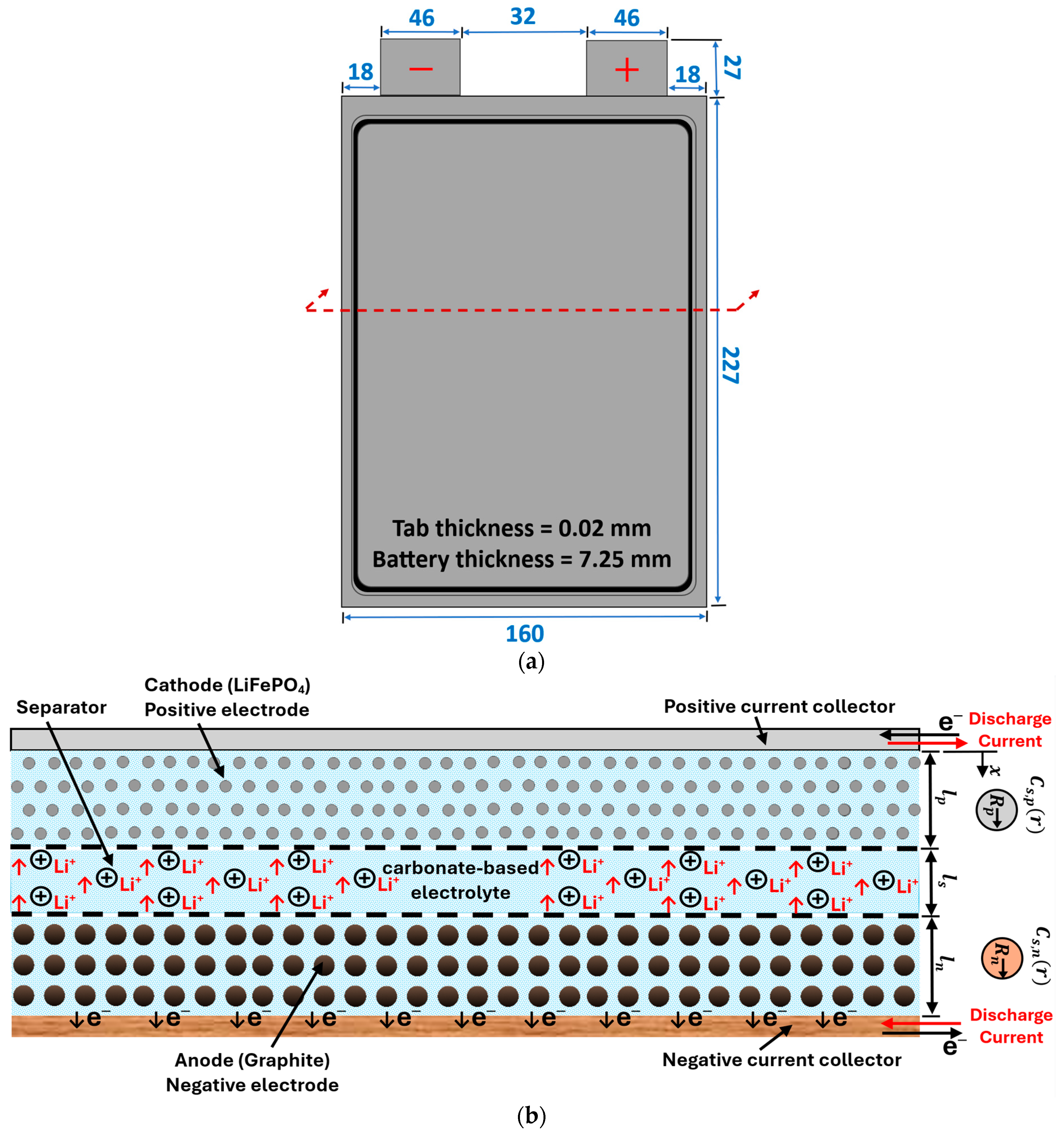


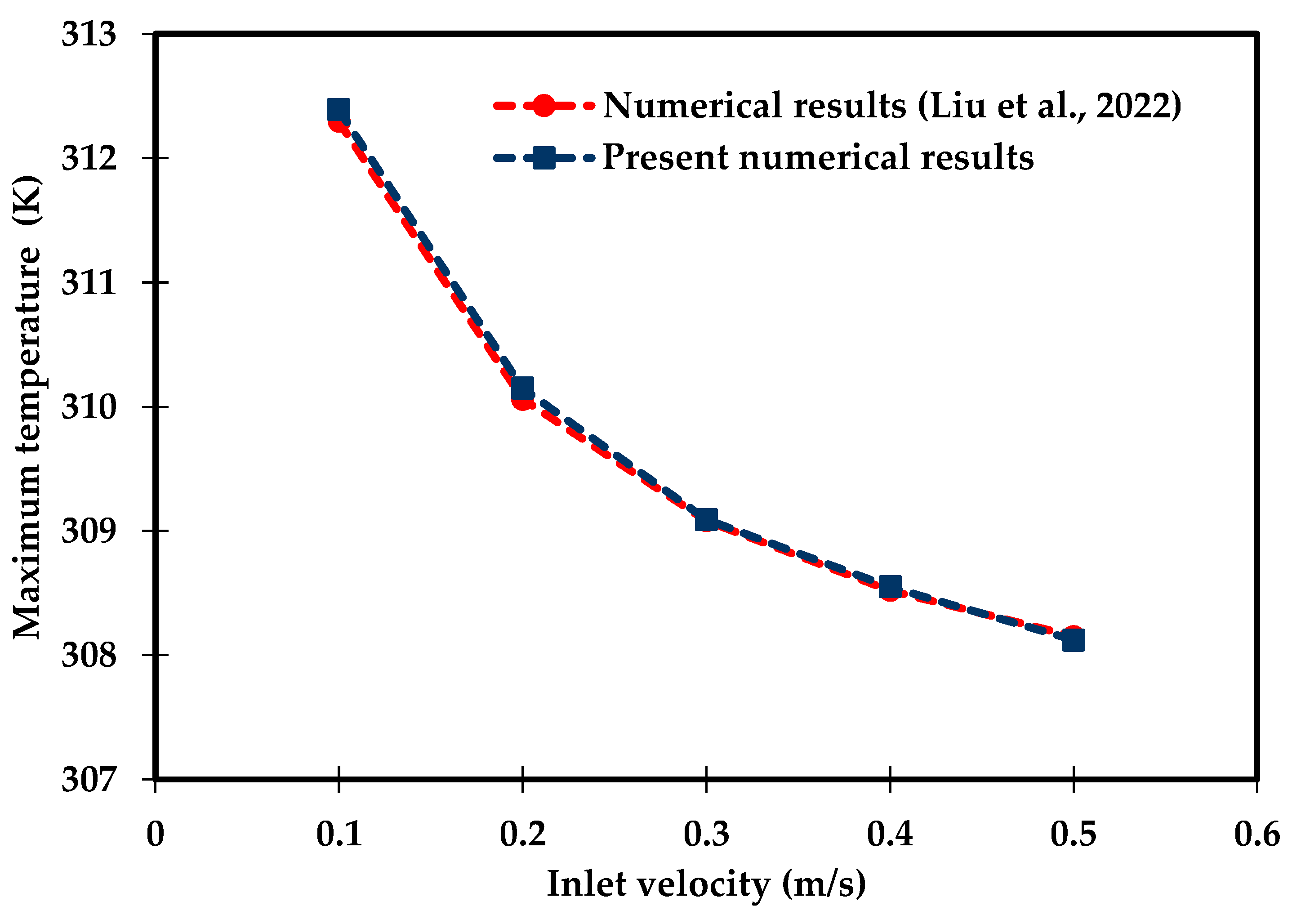
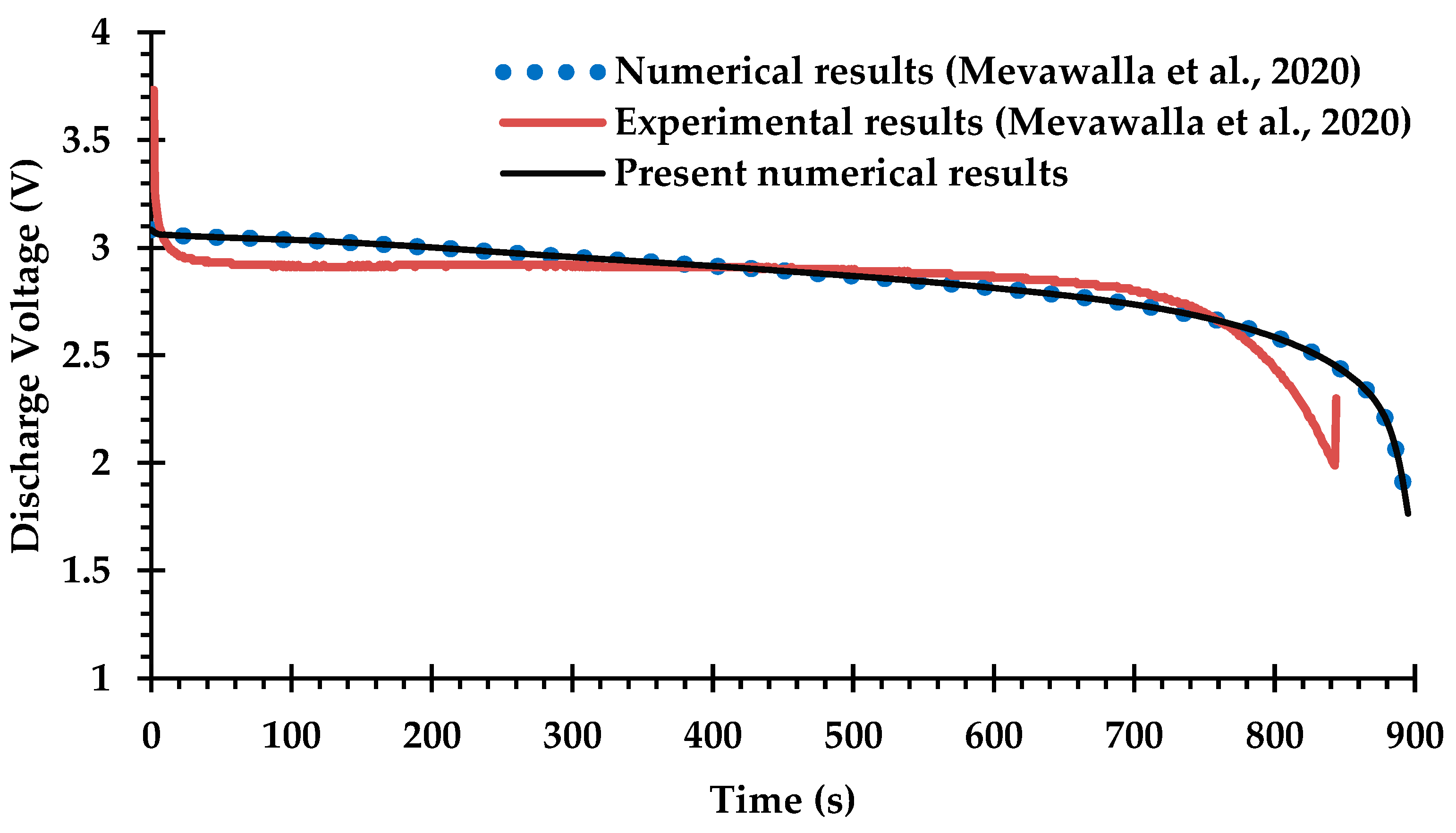


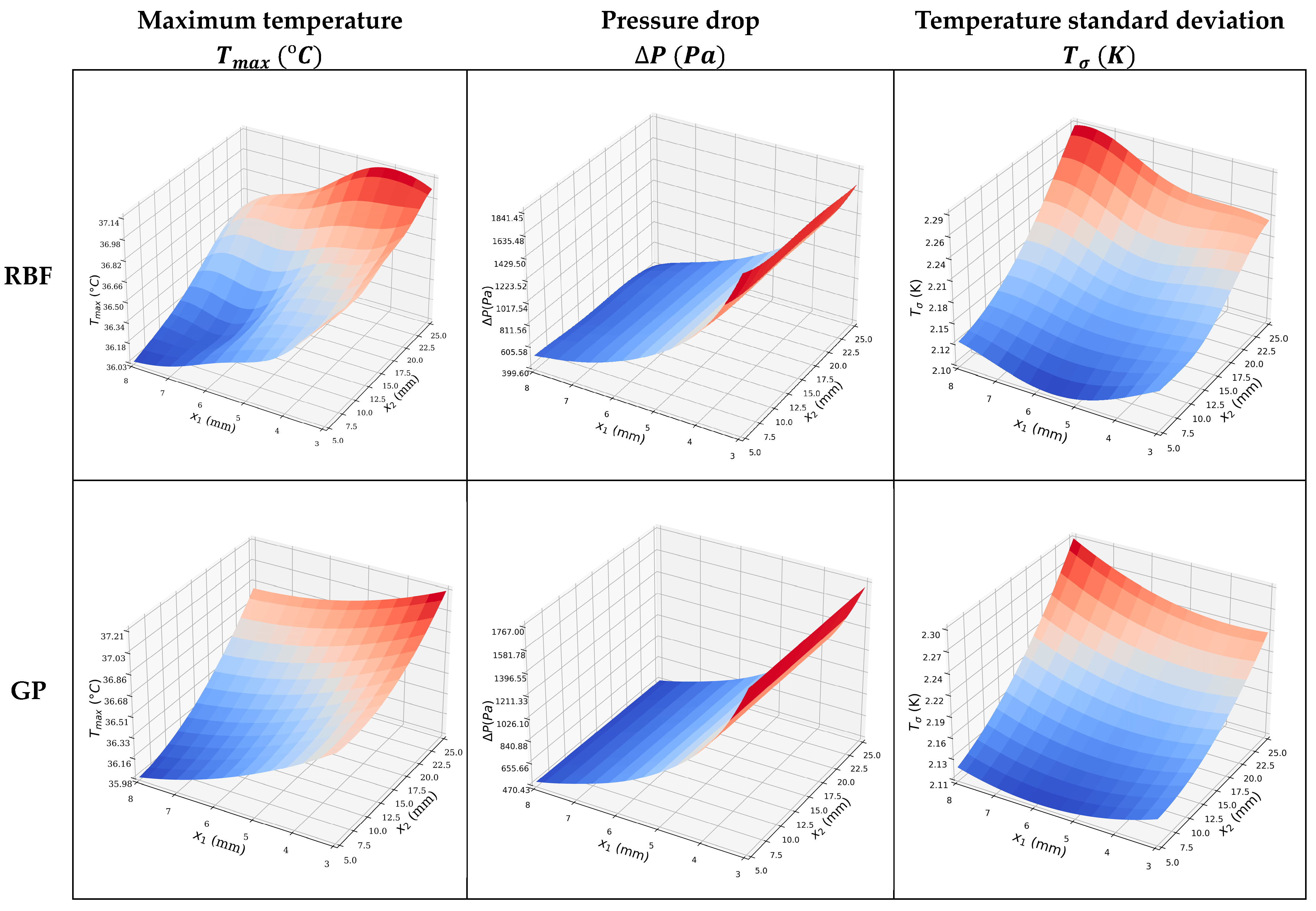
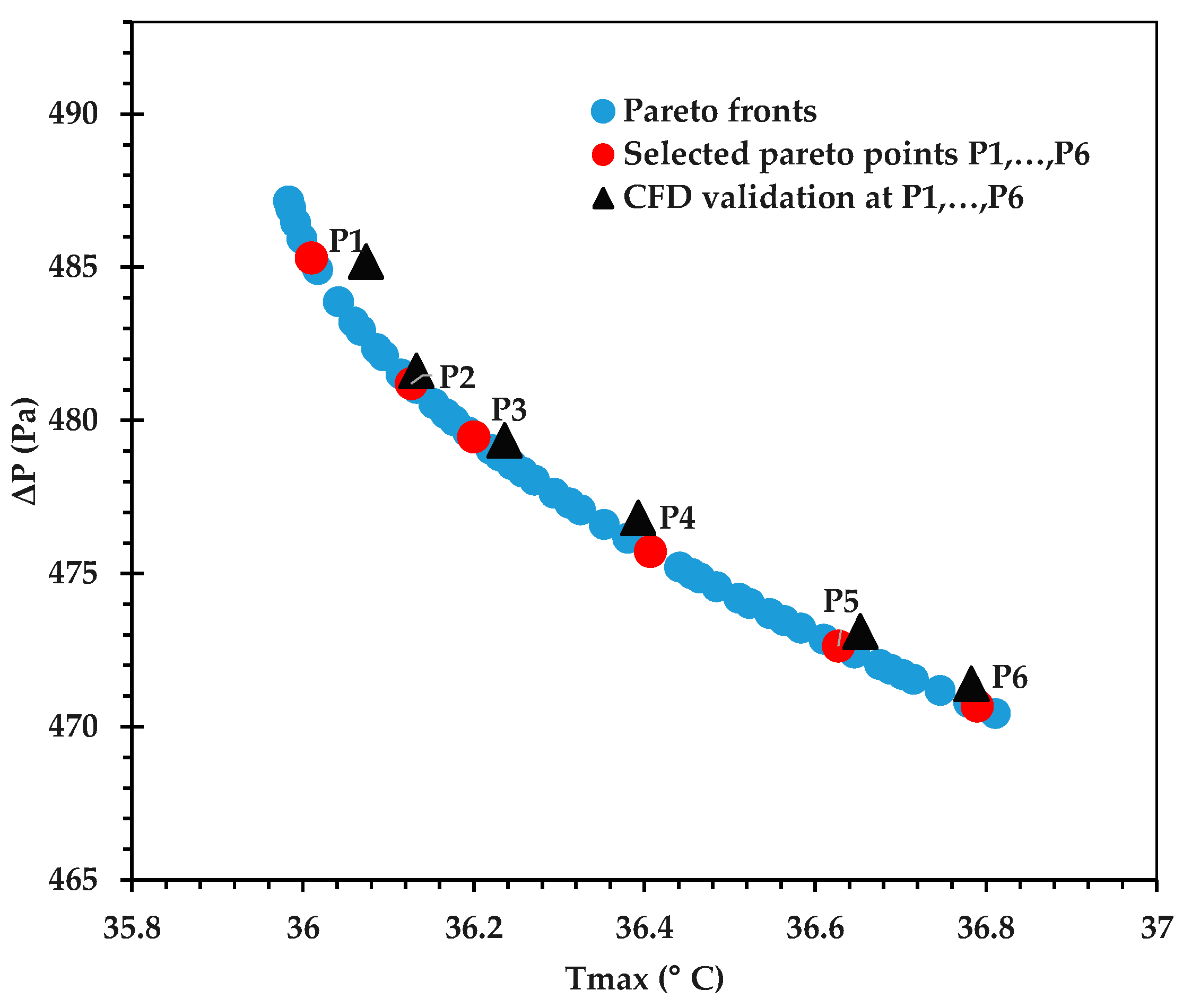
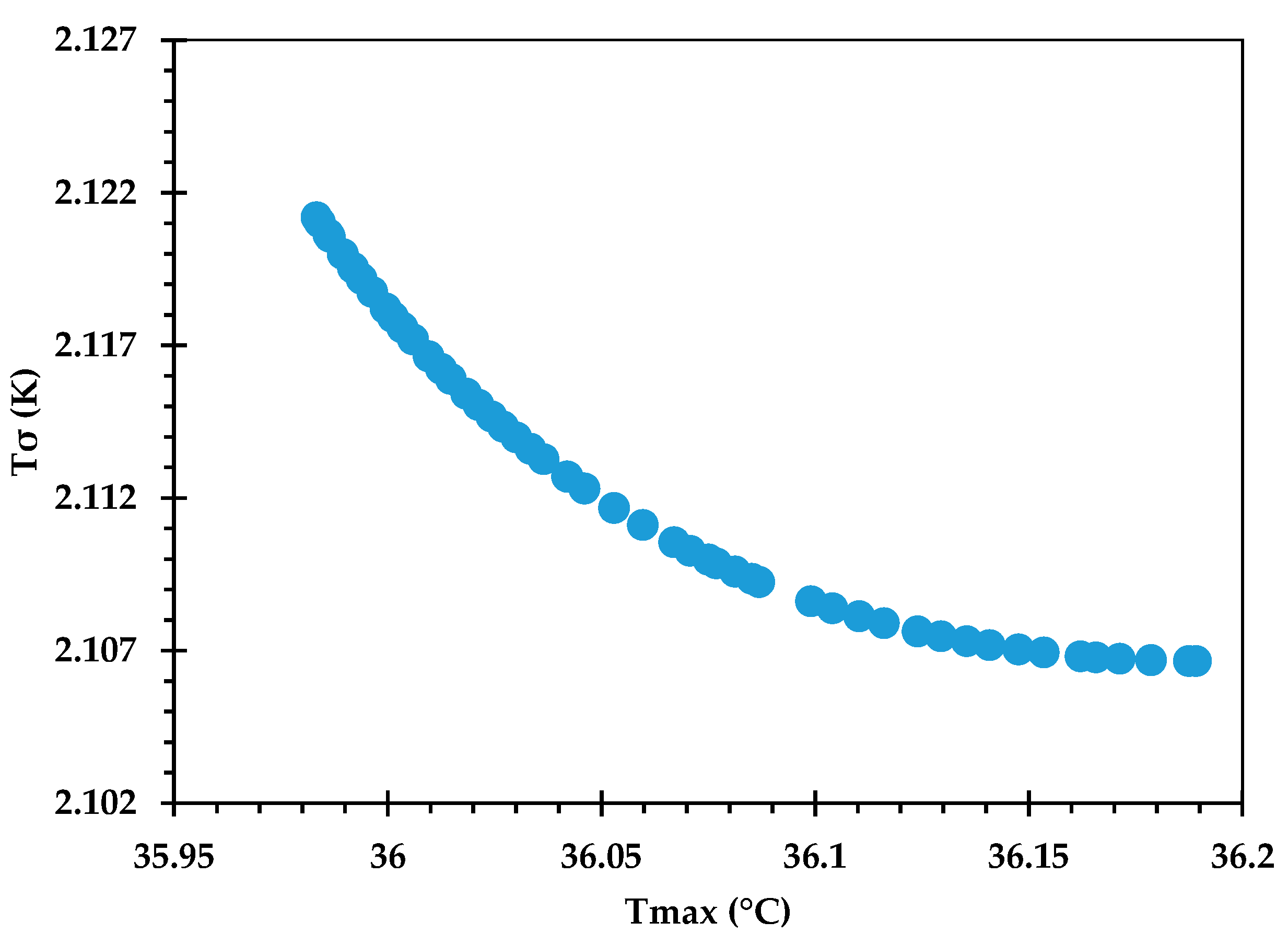
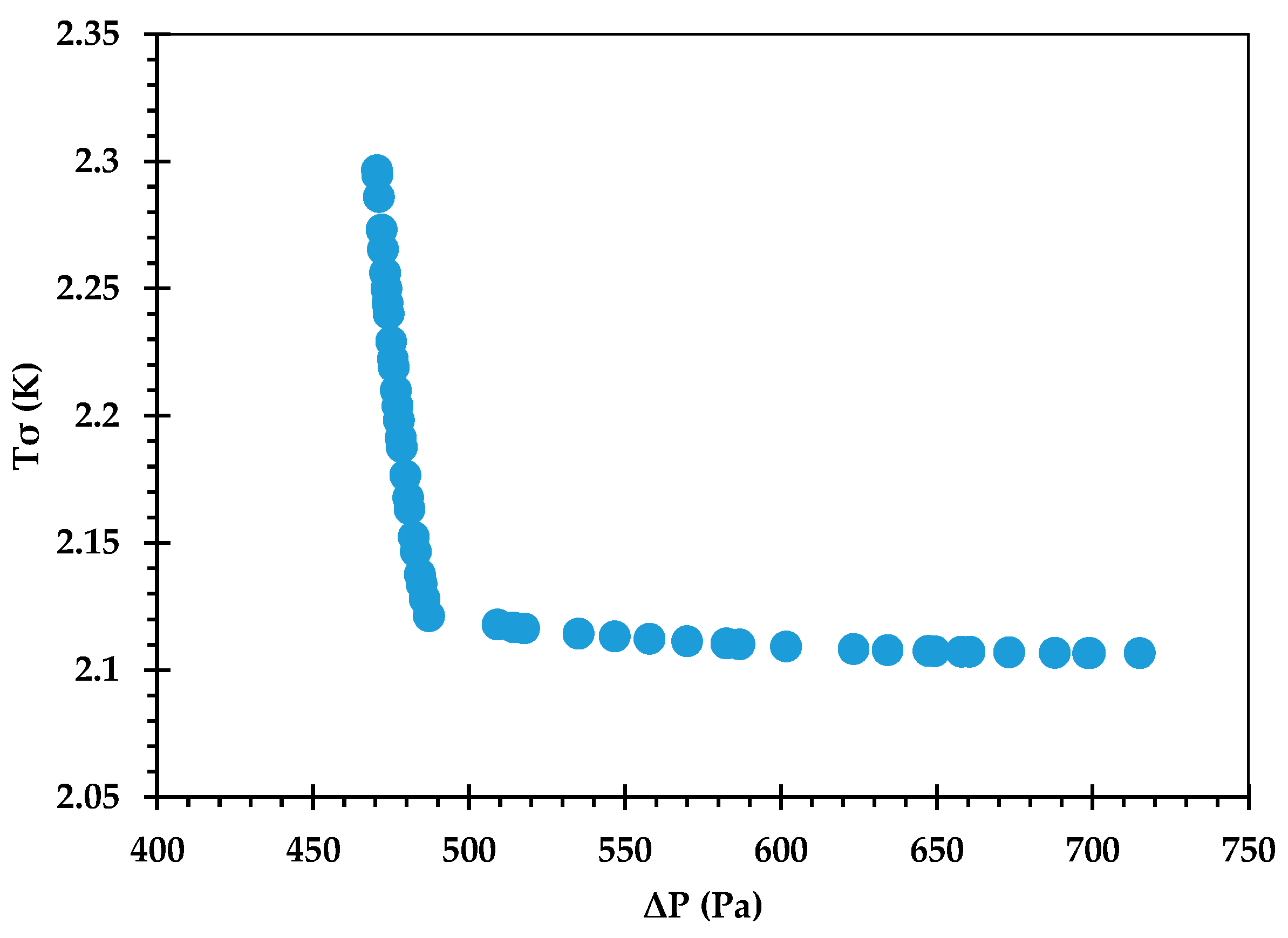

| Specification | Value | Unit |
|---|---|---|
| Material for electrolyte | Carbonate based | - |
| Material for anode | Graphite | - |
| Material for cathode | LiFePO4 | - |
| ) | 7.25 | mm |
| ) | 160 | mm |
| ) | 227 | mm |
| ) | m3 | |
| Mass of the cell | 496 | g |
| Nominal voltage | 3.3 | V |
| Nominal cell capacity | 20 | Ah |
| Number of cycles | Min. 300, approx. 2000 | Cycles |
| Internal resistance | 0.5 | mΩ |
| Nominal energy | 65 | Wh |
| Discharge power | 1200 | W |
| Energy density | 247 | Wh/L |
| Specific energy | 131 | Wh/kg |
| Specific power | 2400 | W/kg |
| Operating temperature | −30 to 55 | °C |
| Storage temperature | −40 to 60 | °C |
| Assumption | Description |
|---|---|
| Simultaneous charge and mass conservation in electrolyte and electrodes [46] | In a closed cell system, mass conservation applies to the ionized lithium in the electrolyte, and simultaneous charge conservation occurs due to the unit charge carried by the lithium ion. The same conservation principles that apply to the electrolyte also apply to the electrode. |
| Porous-electrode theory [47] | Both the electrolyte and electrode phases are modeled as a continuous medium, indicating that both the phases are assumed to exist at all points in space. |
| Space dependence | All equations in the EC model are solved as a function of the cell thickness (x), except for the diffusion in the solid phase, which is expressed in spherical coordinates (r). |
| Concentrated solution theory [48] | In the electrolyte region, the mass and charge conservation equations are defined using the concepts of concentrated solution theory. This theory becomes particularly applicable in concentrated solutions where the diffusing species interact with each other. |
| Spherical-shaped particles | The diffusion equation, which represents mass conservation in the solid phase, is solved using spherical coordinates to determine the Li surface concentration. |
| Temperature Range (K) | ) |
|---|---|
| 1.0–19.5 | |
| 19.5–50.6 | |
| 50.6–200.0 | |
| 200.0–933.0 |
| Parameter | Symbol | Value | Unit |
|---|---|---|---|
| Initial electrolyte Li-ions concentration | Ce,0 | 2100 | mol/m3 |
| Electrolyte reference concentration | Ce,ref | 1000 | mol/m3 |
| Initial Li-ions concentration in the intercalation particle for negative electrode | Cs,n,0 | 30,500 | mol/m3 |
| Initial Li-ions concentration in the intercalation particle for positive electrode | Cs,p,0 | 1900 | mol/m3 |
| Maximum Li-ions concentration in the intercalation particle for positive electrode | Cs,max,p | 21,190 | mol/m3 |
| Maximum Li-ions concentration in the intercalation particle for negative electrode | Cs,max,n | 31,507 | mol/m3 |
| Thickness of positive electrode | lp | 183 | µm |
| Thickness of separator | ls | 52 | µm |
| Thickness of negative electrode | ln | 100 | µm |
| Intercalation particle’s radius for positive electrode | Rp | 8 × 10−6 | m |
| Intercalation particle’s radius for negative electrode | Rn | 5.5 × 10−6 | m |
| Electrolyte phase volume fraction, positive electrode | ϵe,p | 0.54 | - |
| Electrolyte phase volume fraction, negative electrode | ϵe,n | 0.6 | - |
| Volume fraction for separator | ϵsep | 1 | - |
| Electrode phase volume fraction, positive electrode | ϵs,p | 0.39 | - |
| Electrode solid phase volume fraction, negative electrode | ϵs,n | 0.379 | - |
| Filler volume fraction for positive electrode | ϵf,p | 0.07 | - |
| Filler volume fraction for negative electrode | ϵf,n | 0.021 | - |
| Electrical conductivity of the solid phase for positive electrode | σs,p | 91 | S/m |
| Electrical conductivity of the solid phase for negative electrode | σs,n | 100 | S/m |
| Electrolyte electrical conductivity | σe | σe(C/Ce,ref) | S/m |
| Solid phase diffusion coefficient for positive electrode | Ds,p | 3.2 × 10−13 | m2/s |
| Solid phase diffusion coefficient for negative electrode | Ds,n | ) | m2/s |
| Diffusivity of the electrolyte | De | 7.5 × 10−11 | m2/s |
| Maximum negative electrode state of charge | 0.98 | - | |
| Minimum negative electrode state of charge | 0 | - | |
| Maximum positive electrode state of charge | 0.9 | - | |
| Minimum positive electrode state of charge | 0.01 | - | |
| Thermal conductivity for positive electrode | K pos | 1 | W/m·K |
| Thermal conductivity for negative electrode | K neg | 1 | W/m·K |
| Heat capacity at constant pressure for positive electrode | Cp, pos | 881 | J/kg·K |
| Heat capacity at constant pressure for negative electrode | Cp, neg | 750 | J/kg·K |
| Density for positive electrode | p | 3600 | kg/m3 |
| Density for negative electrode | n | 2300 | kg/m3 |
| Reference exchange current density for positive electrode | io,ref,p | 20 | A/m2 |
| Reference exchange current density for negative electrode | io,ref,n | 25 | A/m2 |
| ) | 119 | A/m2 | |
| Activity dependence of the electrolyte | 0 | - | |
| Transfer coefficient for anode | ∝a | 0.5 | - |
| Transfer coefficient for cathode | ∝c | 0.5 | - |
| Li-ion transport number for electrolyte | t+ | 0.363 | - |
| Film resistance on negative electrode | Rfilm,n | 0.02 | Ωm2 |
| Bruggeman porosity exponent | β | 1 | - |
| Universal gas constant | R | 8.3143 | J/(mol·K) |
| Faraday’s constant | F | 96,485 | coulomb/mol |
| Nominal capacity of cell | C | 20 | Ah |
| Minimum stop voltage | Vmin | 2.0 | V |
| Maximum stop voltage | Vmax | 4.1 | V |
| Reference temperature | Tref | 298 | K |
| Initial temperature | TInitial | 22.88 | °C |
| Tab thickness | 0.02 | mm | |
| Density for battery material | 2055.2 | kg/m3 | |
| Specific heat for battery material | 1399.1 | J/kg·K | |
| Thermal conductivity for battery material | 0.8972 | W/m·K |
| Locations | Fluid Conditions | Thermal Conditions |
|---|---|---|
| Inlet | Laminar and fully developed flow = 3 g/s) | ) |
| Outlet | ) | In the normal direction, the temperature gradient is zero. |
| Interface surface | No-slip flow = 0 | |
| Incompressible flow | (density) = constant | - |
| Gravity force | Gravity is not considered. | - |
| Free convection boundary conditions | U = 0 | |
| Radiation heat transfer | U = 0 | ). |
| Symmetrical plane of the battery pack | Half of the battery module is considered (Figure 2). | |
| Temperature Range (K) | Density (kg/m3) | |
|---|---|---|
| Tab [43] | 20.0–130.0 | |
| 130.0–933.0 | ||
| Specific heat capacity (J/kg·K) | ||
| 100.0–320.0 | ||
| 320.0–933.0 | ||
| Thermal conductivity (W/m·K) | ||
| 0.0–14.0 | ||
| 14.0–50.0 | ||
| 50.0–82.0 | ||
| 82.0–297.0 | ||
| 297.0–933.0 | ||
| Cooling fluid (Water) [62] | Density (kg/m3) | |
| 273.15–293.15 | ||
| 293.15–373.15 | ||
| Specific heat capacity (J/kg·K) | ||
| 273.15–553.75 | ||
| Thermal conductivity (W/m·K) | ||
| 273.15–553.75 | ||
| Viscosity (Pa·s) | ||
| 273.15–413.15 | ||
| Cold plate (Aluminum) [62] | 413.15–553.75 | |
| Density (kg/m3) | ||
| 2700 | ||
| Specific heat capacity (J/kg·K) | ||
| 900 | ||
| Thermal conductivity (W/m·K) | ||
| 238 |
| Number of Elements | ||||
|---|---|---|---|---|
| 1.07 × 10⁶ | 36.010 | 780.98 | 1.164 | 0.946 |
| 2.42 × 10⁶ | 35.997 | 772.66 | 1.199 | 2.001 |
| 3.63 × 10⁶ | 36.386 | 782.82 | 0.131 | 0.712 |
| 5.38 × 10⁶ | 36.477 | 787.39 | 0.118 | 0.133 |
| 5.94 × 10⁶ | 36.434 | 788.44 | 0.000 | 0.000 |
| Objective Function | No. of Restarts Optimizer | ) | Length Scale Range |
|---|---|---|---|
| 10 | 2 | (1 × 10−2, 1 × 102) | |
| 25 | 2 | (1 × 10−2, 1 × 102) | |
| 10 | 2 | (1 × 10−2, 1 × 102) |
| ML Model | RBF | GP |
|---|---|---|
| 0.043 | ||
| 0.001 | ||
| 0.001 | 0.004 |
| Objective Function | Global Minima | |||||
|---|---|---|---|---|---|---|
| 35.98 | 8.00 | 5.00 | 35.98 | 487.1 | 2.121 | |
| 470.4 | 8.00 | 25.00 | 36.81 | 470.4 | 2.296 | |
| 2.107 | 5.93 | 5.00 | 36.18 | 714.8 | 2.107 |
| Parameter | Value |
|---|---|
| Variant | “DE/rand/1/bin” |
| Maximum number of generations | 200 |
| Size of the population in each generation | 50 |
| Crossover parameter (Cr) | 0.7 |
| Scale factor or mutation parameter (F) | (0.0, 1.0) |
| Points | Design Variables (mm) | Error % | ||||||
|---|---|---|---|---|---|---|---|---|
| Pareto | CFD | Pareto | CFD | |||||
| 8.000 | 7.232 | 36.010 | 36.074 | 485.300 | 485.190 | 0.178 | 0.023 | |
| 8.000 | 12.144 | 36.127 | 36.133 | 481.200 | 481.620 | 0.017 | 0.087 | |
| 8.000 | 14.227 | 36.200 | 36.236 | 479.459 | 479.350 | 0.099 | 0.023 | |
| 8.000 | 18.690 | 36.407 | 36.393 | 475.723 | 476.820 | 0.038 | 0.231 | |
| 8.000 | 22.371 | 36.627 | 36.653 | 472.638 | 473.110 | 0.071 | 0.100 | |
| 8.000 | 24.710 | 36.790 | 36.783 | 470.675 | 471.400 | 0.018 | 0.154 | |
| Design | Design Variables (mm) | Error % | |||||||||
|---|---|---|---|---|---|---|---|---|---|---|---|
| Pareto | CFD | Pareto | CFD | Pareto | CFD | ||||||
| 1 | 8.000 | 5.000 | 35.983 | 36.096 | 487.16 | 487.15 | 2.1212 | 2.1227 | 0.312 | 0.002 | 0.071 |
| 2 | 6.564 | 5.000 | 36.113 | 36.053 | 630.30 | 629.53 | 2.1080 | 2.1048 | 0.167 | 0.122 | 0.153 |
| 3 | 5.937 | 5.000 | 36.189 | 36.260 | 715.13 | 715.41 | 2.1067 | 2.1077 | 0.195 | 0.039 | 0.049 |
| 4 | 8.000 | 16.227 | 36.285 | 36.328 | 477.79 | 477.28 | 2.1953 | 2.1919 | 0.118 | 0.106 | 0.154 |
| 5 | 8.000 | 17.475 | 36.345 | 36.368 | 476.74 | 478.94 | 2.2074 | 2.2087 | 0.064 | 0.459 | 0.060 |
| 6 | 8.000 | 18.794 | 36.413 | 36.454 | 475.64 | 474.55 | 2.2210 | 2.2210 | 0.112 | 0.229 | 0.000 |
| 7 | 8.000 | 21.169 | 36.550 | 36.480 | 473.65 | 473.06 | 2.2477 | 2.2371 | 0.193 | 0.125 | 0.472 |
| 8 | 8.000 | 23.335 | 36.692 | 36.696 | 471.83 | 471.92 | 2.2744 | 2.2700 | 0.011 | 0.019 | 0.192 |
| 9 | 8.000 | 24.236 | 36.755 | 36.776 | 471.07 | 469.99 | 2.2861 | 2.2866 | 0.056 | 0.230 | 0.020 |
| 10 | 8.000 | 25.000 | 36.811 | 36.831 | 470.43 | 471.46 | 2.2964 | 2.2995 | 0.054 | 0.218 | 0.134 |
| Acronym | Bound | Benchmark Design | Optimum Candidate Design | |
|---|---|---|---|---|
| Design variables | (3–8) (5–25) | 5.5 15.0 | 8.00 5.00 | |
| Objective functions | Minimization Minimization Minimization | 36.38 782.82 2.14 | 35.98 487.16 2.12 |
Disclaimer/Publisher’s Note: The statements, opinions and data contained in all publications are solely those of the individual author(s) and contributor(s) and not of MDPI and/or the editor(s). MDPI and/or the editor(s) disclaim responsibility for any injury to people or property resulting from any ideas, methods, instructions or products referred to in the content. |
© 2024 by the authors. Licensee MDPI, Basel, Switzerland. This article is an open access article distributed under the terms and conditions of the Creative Commons Attribution (CC BY) license (https://creativecommons.org/licenses/by/4.0/).
Share and Cite
Mahmood, A.; Cockerill, T.; de Boer, G.; Voss, J.; Thompson, H. Heat Transfer Modeling and Optimal Thermal Management of Electric Vehicle Battery Systems. Energies 2024, 17, 4575. https://doi.org/10.3390/en17184575
Mahmood A, Cockerill T, de Boer G, Voss J, Thompson H. Heat Transfer Modeling and Optimal Thermal Management of Electric Vehicle Battery Systems. Energies. 2024; 17(18):4575. https://doi.org/10.3390/en17184575
Chicago/Turabian StyleMahmood, Ahmed, Timothy Cockerill, Greg de Boer, Jochen Voss, and Harvey Thompson. 2024. "Heat Transfer Modeling and Optimal Thermal Management of Electric Vehicle Battery Systems" Energies 17, no. 18: 4575. https://doi.org/10.3390/en17184575
APA StyleMahmood, A., Cockerill, T., de Boer, G., Voss, J., & Thompson, H. (2024). Heat Transfer Modeling and Optimal Thermal Management of Electric Vehicle Battery Systems. Energies, 17(18), 4575. https://doi.org/10.3390/en17184575







